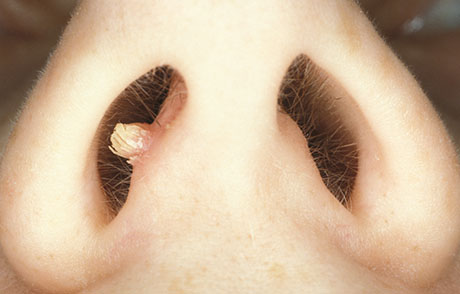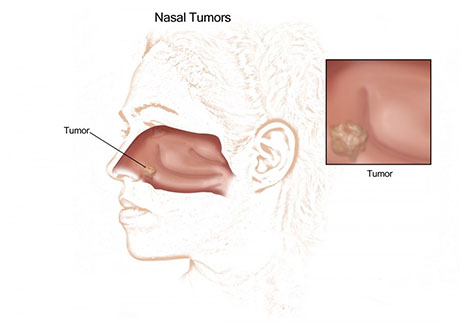What is a nasal tumor?
Tumour is Latin for swelling but not all swellings are cancer.
Benign tumours grow slowly and do not invade into the local structures. These are the most common variety in the sinonasal cavity.
Malignant tumours are most commonly called cancer. These tumours invade the local tissues and can also spread to distant parts of the body.
Sinonasal tumours are rare and make up only 10% of all head and neck tumours with about 10 people in one million being affected every year. They can arise from any structures in the nose (the lining, blood vessels, nerves and even bone or cartilage).


Benign tumours
- · Nasal polyps
- · Inverted papilloma: A one sided warty, slow-growing tumour that can be similar to a nasal polyp with a nasal blockage.
- · Haemangioma: A collection of blood vessels that usually brings nosebleeds and nasal blockage.
- · Osteoma: A bony, smooth non-tender swelling.
- · Angiofibroma: A collection of fibrous tissue and blood vessels that appear on one side with nasal obstruction and occasional nose bleeds. It is typically found in teenage boys.
Malignant tumours
These tumours are rare but the most common are listed below.
- · Squamous cell cancer: Make up the majority.
- · Lymphoma: Tumors of the immune system.
- · Melanoma: Derived from pigmented cells similar to those that cause skin cancer.
- · Adenocarcinoma: Has been shown to be more common in those people who work in with hard woods.

What are the symptoms?
The symptoms you have can depend on where the disease is within the nose and sinuses. The symptoms can be as follows:
- · Nasal cavity: One-sided nasal obstruction with or without a mucus nasal discharge, crusting or nosebleeds.
- · Maxillary sinus: As this is below the eye, diseases can be confined within the sinus or extend forwards causing swelling of the cheek, upwards into the eye socket or sideways into the nasal cavity.
- · Frontal sinus: Swelling of the sinus above the eye on the forehead can cause localised swelling and may even push the eye down causing double vision. Pain is not a common feature.
- · Ethmoidal sinuses: Disease of the sinuses between the eyes can push into the nasal cavity, blocking it, or extend into the eye socket displacing the eye again causing double vision.
Treatment
It is important to seek advice from your family doctor who can then refer you on if necessary to an ear nose and throat surgeon for further examination or who may arrange for special imaging.
Most nasal problems are benign and treatment is usually by surgery. If surgery is undertaken, most benign tumours are removed using special telescopes through the nose.
By Mark Johnston and Nick Jones, Queens Medical Centre, Nottingham
Disclaimer
The details in this section are for general information only. Always check with your own doctor.